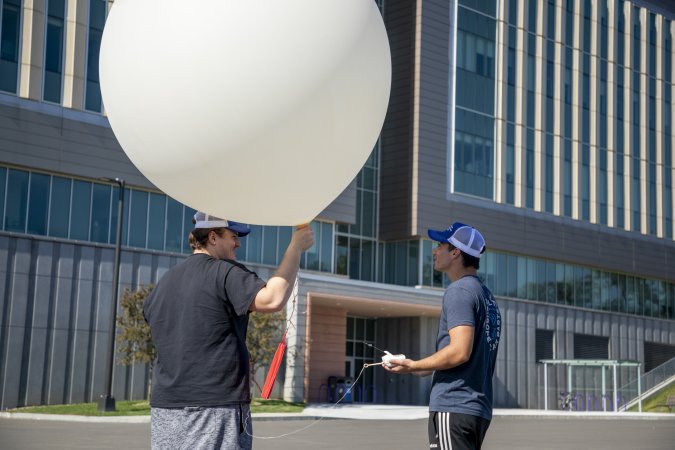UAlbany Students Prepare to Launch Weather Balloons for NASA Eclipse Project
By Mike Nolan
ALBANY, N.Y. (Oct. 5, 2023) — More than 1,000 weather balloons will float high up into the atmosphere next Saturday as an annular solar eclipse sweeps across the United States — including balloons launched by students at the University at Albany.
A team of a half dozen students in the Department of Atmospheric and Environmental Sciences (DAES) at UAlbany's College of Arts and Sciences were among the 53 teams from 75 institutions selected to participate in the 2023-24 Nationwide Eclipse Ballooning Project (NEBP), co-sponsored by NASA and the National Science Foundation.
The Nationwide Eclipse Ballooning Project will take advantage of both the Oct. 14 annular eclipse — where the outer corona of the sun remains visible — and the April 8, 2024, total solar eclipse, launching weather balloons to collect and analyze data, while also providing learning opportunities and experiences for STEM college students.
The teams, which total about 750 students, will launch this weekend from Oregon, Nevada, Utah, New Mexico and Texas, all states where the annular eclipse will be visible, weather permitting. April’s total eclipse will be visible in the Northeast.
UAlbany’s team, the “Turbulent Eddies,” is launching from New Mexico starting on Friday night, through the end of the eclipse event, with faculty support from June Wang, program manager of the New York State Mesonet, a statewide weather observation network operated by UAlbany, and Troy Zaremba, a postdoctoral researcher at DAES.
“The goal with this project is for students to learn about the fundamentals of a solar eclipse,” said Wang, who is part of the NEBP’s leadership team. “It’s also about educational outreach. This project will offer students a unique, hands-on opportunity to work directly with NASA and observe and analyze data from the atmosphere.”
Jeff Freedman, a research faculty member at UAlbany’s Atmospheric Sciences Research Center, and Justin Minder, associate professor in the Department of Atmospheric and Environmental Sciences, and Bhupal Shrestha, a senior research support specialist at the NYS Mesonet, are also supporting the project.
Freedman has been preparing the students this semester through a one-credit training course, which is part of the project. It includes practice weather balloon launches from the ETEC parking lot.
“What they will be able to get from this project are profiles of the atmosphere,” Freedman said. “The eclipse events are essentially turning off the sun in the middle of the day. What does the atmosphere do? How does it react to that?”
“This is a chance for our students to really, from the beginning to the end, run a field project, collect the data and analyze it. They are running the show.”
Eclipse Weather Data
Weather balloons offer a wide range of atmospheric data that can help improve forecast models such as pressure, temperature, relative humidity and wind speed and direction.
During flights, data is collected and transmitted to a ground computer through a small, expendable instrument package, called a radiosonde, that is attached to the balloon. Each flight lasts around two hours, during which the balloon drifts up to 125 miles and can reach an altitude of 100,000-plus feet.
Christopher Gilberti, a senior at DAES, is among the students traveling to New Mexico this weekend.
“In class, we’ve learned about the importance of the data that weather balloons collect for both research and forecasting purposes,” said Gilberti, the student team leader for UAlbany. “It’s rare to get two eclipses in one year. This is a valuable experience for us to expand on past studies about eclipses and learn more about how they impact the atmosphere.”
DAES senior Evan Belkin is also part of the UAlbany team. This will be his second time launching weather balloons in partnership with NASA.
Chris and Evan both supported NASA’s Investigation of Microphysics and Precipitation for Atlantic Coast-Threatening Storms (IMPACTS) mission, which used scientific instruments, including weather balloons, to track and better understand snowstorms.
“It’s beyond my wildest dreams to be able to have this type of research experience as an undergraduate student,” Belkin said. “Our department provides countless opportunities, like this one, to go out in the field and collect atmospheric data that is being used to improve forecasting.”
Rare Eclipse Event
Next April, a total solar eclipse will cross North America, passing over Mexico, the U.S., and Canada. During a total solar eclipse, the moon passes between the sun and Earth, blocking the sun's light and darkening the sky. The last time it took place over the U.S. was in August 2017, when people were able to see the event across the entire continent for the first time in nearly 100 years.
UAlbany students will again launch weather balloons during this event through the NASA project, but much closer to home, near Watertown, N.Y. The students will be comparing atmospheric data from the balloon launches to real-time data from nearby NYS Mesonet sites.
The weather balloons will monitor for changes in the atmosphere at as high as 115,000 feet, launching each hour for 30 hours along the eclipse path. Some of the balloons will offer a live stream from the stratosphere —100,000 feet up — available for viewing on the NASA eclipse website.
Students will publish research papers based on their findings from both launches.






